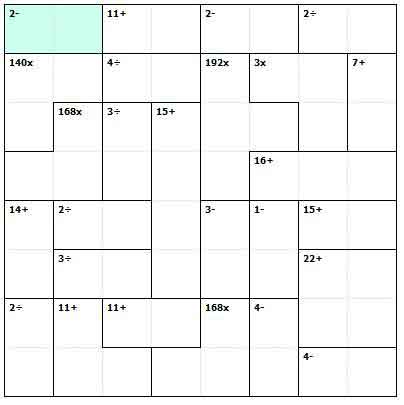
Cyber Home of Tom Pears
Applying Appropriate Technology to Learning

|
Cyber Home of Tom Pears |
|
Contents HomeBooks WhatILearned Our New House PrincetonVisit Kawanhee Truck Postcard A Letter Pics I Bought Pics Not Owned Spoon Ad AH Davenport Go Old Topics |
Kenken
Below is a Kenken puzzle from Will Shorts Crazy for KenKen Killer book.
As I said, I have done Sudoko for years, especially since I returned to teaching high school math in 2005.
The students love it. It is a great example of how math can be fun. Everyone loves solving a puzzle, getting a problem correct. The wonderful
crux of the problem is helping them to see the difference between wild guessing and having a strategy.
There are so many great things about these types of puzzles! I guess the best one is that you can start off with something as simple as a 3x3 grid and move up as you achieve proficientcy. You can have a continuium of puzzles from easy to hard at each size. Students love to have the success of completing the easy puzzle and then move on to the harder WHEN THEY, NOT the teacher, decide to do so. And while you should have an "Answer Sheet" for each puzzle, the students can actually check their own and/or their partners. Checking each row and column for one and only one of the numbers 1-X is something most can do with ease. The key to any successful strategy of course is to avoid wild guessing. This whole topic of guessing is a lot more complicated than you might at first think. In class with my 9th graders in Lawrence MA, I would hand out the Sudoko puzzle (maybe 6x6), reproduce it on the board, and ask for a vulunteer to come up, fill in one empty square AND, MOST IMPORTANT, argue for why the fill in HAD to be that number. This presentation of WHY got many students involved and allowed the ones with less Sudoko skills to keep up. If you have ever done such puzzles, you know that the worest possible thing to do is to make a mistake. Once the mistake is revealed by an inconsistency, there is no way to be sure which numbers should be errased. You really have to start over again. There are no RECOVERY points that you can return to. At first, I had a lot of students who just guessed wildly and kept asking for a new blank puzzle once they found a mistake. I of course kept saying over and over DO NOT GUESS. Only recently have I realized that DO NOT GUESS is the wrong message. That phrase obscures the real problem. In fact, we all guess all the time!! That is how we do the puzzles!! Everyone guesses for every square!! What I should have been saying is "Don't write a number down until you are sure it is the only number that will work in that square". It is a 2 step process. 1.Come up with a number that you think will work. 2.Prove that all the other numbers 1-X CAN'T go in that square, or, the same thing, that the number you want to put in that square can ONLY go in that square and no other in the row, column or "small box". I'm going to divirge for a moment and go down a whole train of thought about "understanding" as opposed to "rebotically carring out a process". Click here if you would like to come with me or, if not, just read on. In a sense, that is what math is all about. AND, when you make a mistake, you are confronted with inconsistency. Often in a math problem the student needs the answer book to "certify" a correct answer. But in these problems, as long as you check your work, a wrong answer really stands out. 5th grade students at Winsor really got into designing their own Sudoko problems! I'm a real proponent. Anyway, I tried Kakuro and did not have the same success. Then in the spring of 2009 I picked up Kenken and have spent hours on it over the summer and fall. After I gained confidence with easy problems, I bought the above Killer book and started working only the harder ones. They are quite a challenge. Most would take me a couple days and a few a week. Then in the fall I hit problem 71! I spent a couple weeks on it. I kept coming back to it. I put it down for all of November and just started again yesterday and finally got it. Here it is. Hope you enjoy it. I'll try to write more about the techniques I have found most successful. 
|